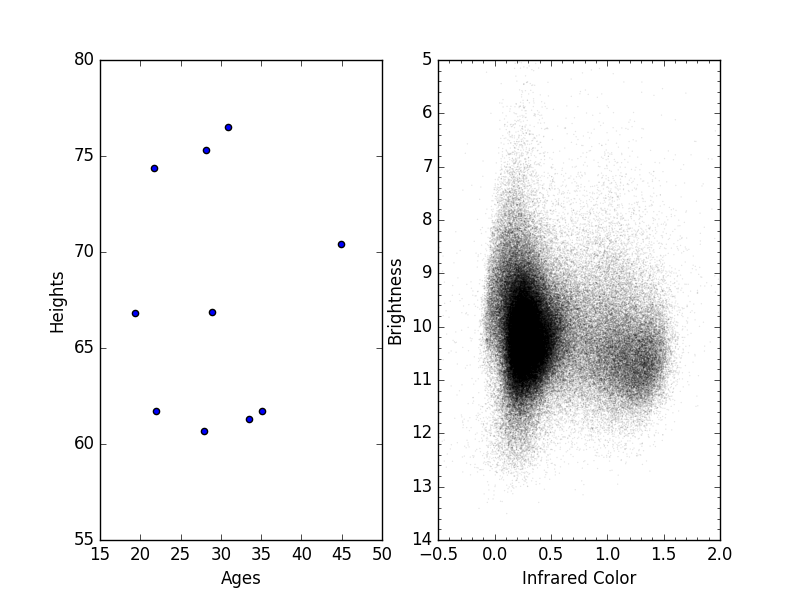Unsupervised Classification¶
Real-world data rarely comes in labeled. However, data tends to naturally cluster around like-things. Consider the following data about stars and galaxies.
In [1]: import pandas as pd
In [2]: data = pd.read_csv("source/downloads/lean_stars_and_galaxies.csv")
In [3]: print(data[:10])
ra decl CLASS w3 col12
0 342.68700 1.27016 GALAXY 9.203 0.270
1 355.89400 1.26540 GALAXY 10.579 0.021
2 1.97410 1.26642 GALAXY 10.678 0.302
3 3.19715 1.26200 GALAXY 9.662 0.596
4 4.66683 1.26086 GALAXY 9.531 0.406
5 5.40616 1.26758 GALAXY 8.836 0.197
6 6.32845 1.26694 GALAXY 11.931 0.196
7 6.89934 1.26141 GALAXY 10.165 0.169
8 8.19103 1.25947 GALAXY 9.922 0.242
9 16.55700 1.26696 GALAXY 9.561 0.061
If I were to visualize this data, I would see that although there’s a ton of it that might wash out clumpy structure there are still some natural clusters in the data.
In [4]: import matplotlib.pyplot as plt
In [5]: plt.scatter(data.col12, data.w3, s=1, edgecolor="None", c='k', alpha=0.1)
Out[5]: <matplotlib.collections.PathCollection at 0x10c1e0160>
In [6]: plt.xlim(-0.5, 2); plt.ylim(14, 5); plt.minorticks_on()
In [7]: plt.xlabel("Infrared Color"); plt.ylabel("Brightness")
Out[7]: <matplotlib.text.Text at 0x10b717940>

An unsupervised classification algorithm would allow me to pick out these clusters. Although it wouldn’t be able to tell me anything about the data (as it doesn’t know anything aside from the numbers it receives), it would give me a starting point for further study.
With this example my algorithm may decide that a good simple classification boundary is “Infrared Color = 0.6”. This would separate my data into left (IR color < 0.6) and right (IR color > 0.6). From there I can investigate further and study this data to see what might be the cause for this clear separation.
Here are examples of some unsupervised classification algorithms that are used to find clusters in data:
- K-Means Clustering
- Gaussian Mixture Models
- Mean Shift
- Hierarchical Clustering
- Neural Networks
